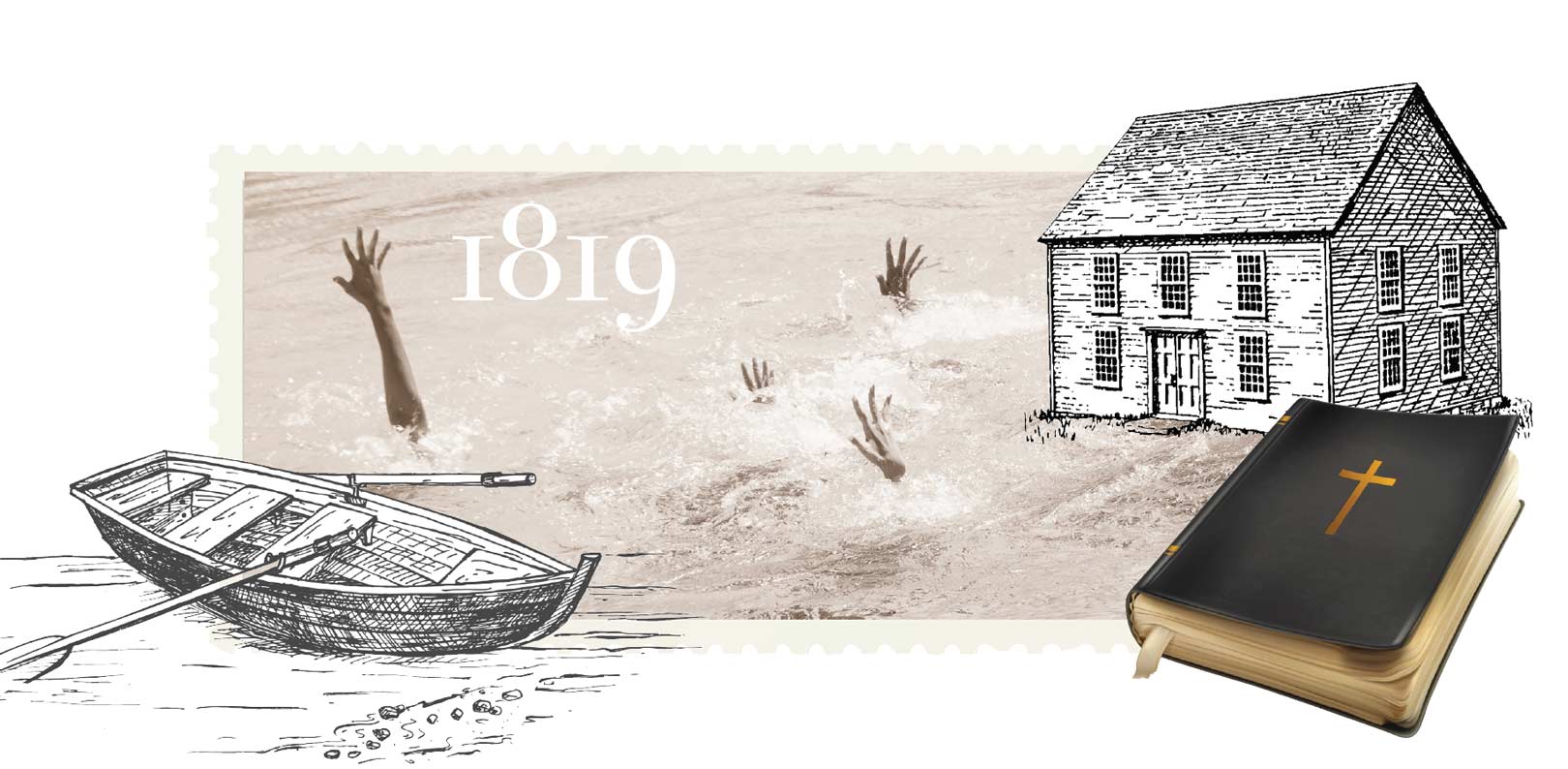
The old Methodist meeting house at Hay Bay is remembered as the oldest church in the region. Less well remembered is the terrible tragedy that happened there, just offshore, in 1819.
One look at the boat, and 13-year-old Gilbert Bogart knew it would be foolish to climb aboard. It was a home-made, flat-bottomed skiff, but not large enough to hold all the people waiting to cross Hay Bay. Nor did it seem very seaworthy, he said, pointing to a bailing bucket in the bow. Gilbert implored everyone, including his big brother, Peter, to remain on shore, but his pleas fell on deaf ears. One by one, 18 people – most of them teens and young adults – hopped aboard for the mile-and-a-half row to the far shore. In an era in which most people could not swim, this proved to be a fateful decision.
It was Sunday morning, August 29, 1819, and the group of young Methodists was late for church. This wasn’t any ordinary Sunday service: it was the special quarterly meeting, and every Methodist in the Quinte district was looking forward to it.
The venue was the plain little Methodist church in Adolphustown Township. Built in 1792 in the wake of the first United Empire Loyalist landing in Quinte, it stood purposefully on the shore of Hay Bay, handy to summertime boat traffic and wintertime sleigh traffic, because roads suitable for carriages hadn’t yet been blazed. The fledgling farm community was barely established, and the church – better described as a meeting house – was one of the few permanent buildings among the log cabins and wooden shanties in the neighbourhood. Indeed, with its austere lines and barn-like appearance, you would probably not recognize it as a church, for it was built according to strict Methodist doctrine, which looked askance at architectural indulgences: no fancy stained windows here, no Gothic steeple. But despite its self-conscious simplicity, the meeting house had become the hub of the local Methodist faith.
On that Sunday morning, the meeting house was already full of worshippers as the rowboat plied across the bay. Those on board could hear the sermon and joined in as hymns were sung. They were that close when disaster struck. While voices were raised in song, the flimsy boat began to take on water. Lots of water. Quickly. Someone started bailing, but the bucket was soon lost. Men began to bail with their hats. One of them, an able swimmer, decided to lighten the load by jumping overboard, but that only made things worse. As he surfaced, he turned around to find the boat capsized and a sea of heads and hands bobbing in the water. Some were already sinking below the surface.
Accounts vary, but what happened next was utter chaos. Survivors later remembered several girls, all non-swimmers, clinging together in a circle, but it was no use. Very quickly, it was everyone for themselves as desperate victims grasped at anything that might help keep them afloat – an oar, a stray board, the capsized boat, but mostly each other. Several of those who could swim were caught in death grips by those who couldn’t. One survivor recalled that it was only by his sheer strength that he was able to fight himself free as he was pulled down in the panic. Alas, several attempts at heroism ended in disaster: poor Peter Bogart, hearing a cry for help from his fiancée, Jane German, tried to guide her toward the upturned boat, only to be pulled under and drowned. Jane drowned, too.
It was all over in a matter of minutes. Inside the church, the congregation heard the shrieks of the victims as the tragedy unfolded. They ran to the water’s edge, but were forced to watch helplessly. Among the onlookers were Jane German’s parents, who also lost their son that day. In all, 10 of the 18 passengers drowned. Eight of them were women, none of whom could swim and all of whom had to fight against the wet weight of their Sunday dresses. In the grim aftermath, a fisherman cast his seine-net into the bay, gathered the bodies in a group and towed them to shore. Most of the victims were buried together in an unmarked grave beside the meeting house.
The Hay Bay tragedy still ranks as one of the worst drowning incidents in Ontario history. Even so, it came close to being wiped from memory. Most of those left behind – such as Gilbert Bogart, who became postmaster at Belleville and lived into his 70s – rarely talked about it. And when the old Hay Bay meeting house was closed in favour of a new brick church up the road, some said good riddance. But the mass drowning has since become part of local lore, especially in the years since the meeting house – one of the few 18th-century buildings in Ontario – was restored as a historic site. In 1961, a stone was erected to commemorate the victims, and in 1993, archaeologists paid a visit to document the site. Every year, on the fourth Sunday in August, the old building is host to a special Sunday service, in which the congregation always pauses to ponder the tragic event from more than 200 years ago and to pay tribute to those who were lost.
Story by:
Tom Cruickshank




